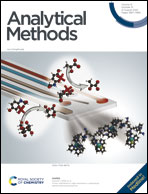Investigating the interaction between three perfluorinated carboxylic acids and the G protein-coupled estrogen receptor: spectroscopic analyses and computational simulations†
Abstract
In this paper, perfluorinated compounds (PFCs), such as perfluorobutyric acid (PFBA), perfluorooctanoic acid (PFOA) and perfluorododecanoic acid (PFDoA), were selected as typical representatives of perfluorinated carboxylic acids (PFCAs) to study the effects of PFCAs on the G protein-coupled estrogen receptor (GPER). The interaction mechanism of the three types of PFCAs with the GPER was investigated using steady-state fluorescence spectroscopy, ultraviolet-visible spectroscopy, three-dimensional fluorescence spectroscopy, and Fourier transform infrared spectroscopy combined with molecular docking and molecular dynamics simulations. Among these techniques, steady-state fluorescence and ultraviolet-visible spectroscopic analyses showed that PFBA, PFOA and PFDoA quenched the endogenous GPER fluorescence by combined dynamic and static quenching and non-radiative energy transfer. The binding constants (Ka) of PFCAs on the GPER were all larger than 105 L mol−1, indicating that their affinity for the GPER was strong. Fourier transform infrared spectroscopy and three-dimensional fluorescence showed that the secondary structure of the GPER changed after binding to PFCAs. Thermodynamic analysis showed ΔG < 0, which indicated that the interaction between the GPER and PFCAs was spontaneous. For the binding of PFBA and PFOA to the GPER, ΔH > 0 and ΔS > 0, indicating that the interaction was mainly driven by hydrophobic forces; for the binding of PFDoA to the GPER, ΔH < 0 and ΔS < 0, suggesting that van der Waals force and hydrogen bonding were the main interaction forces. Molecular dynamics simulations suggested that the stability of the GPER–PFCA complexes was higher than that of the free GPER, and also that the structure and hydrophobicity of the GPER changed after binding to PFCAs. Molecular docking analysis showed that all three PFCAs could form hydrogen bonds with the GPER, which improved the stability of the complex.



 Please wait while we load your content...
Please wait while we load your content...